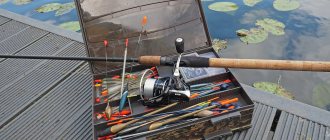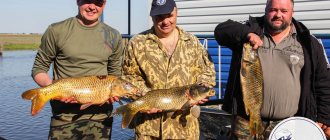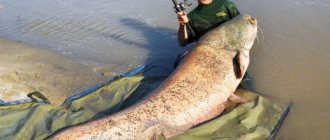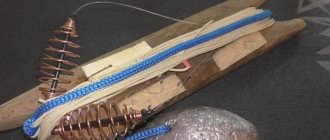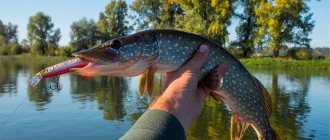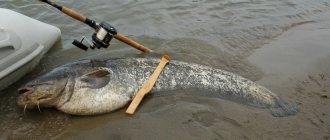Selection and production of kwok
Kwok is a specially made tackle for attracting catfish.
When played correctly, it makes the sound of a frog croaking and this is what attracts the predator to action. Nowadays stores offer a huge selection of different quoks. Most often they are made of metal and wood. The material does not affect the sound produced at all; the size and shape of the quok do.
There are three main elements in the design of a quok:
- patch
- knife
- lever.
The handle is most often made from various types of wood. The main thing is that it is light and comfortable in the hand. It is best for the knife to be made of metal, as thin as possible, so that it can easily cut water, and at the same time there will be less splashes. The piglet is made from various materials: metal, wood, and epoxy resin. The main requirement for it is that it be perfectly smooth.
Well, the most important thing in the design is that the angle between the handle and the knife should be 60 degrees.
Experienced somyatniks make kwok with their own hands and immediately for themselves.
The handle is made of apple or maple. Set the shape and polish well. It makes a cut under the knife. The knife is inserted at the desired angle and sits on the glue. The knife is made from a duralumin plate 28cm long, 5mm thick and 2.5cm wide. can also be made from wood. A snout is attached to the end of the knife.
To make a heel, make a mold from plasticine and fill it with epoxy resin.
After manufacturing the entire structure, it is carefully sanded and varnished.
Catching catfish at night
Night is the best time of day for catching catfish, since it is at night that catfish feed, and preferably in the hole in which they live, as well as at the exits from it. During the day, large individuals most often lie quietly on the bottom, and it is almost impossible to attract their attention. Small catfish can move throughout the entire reservoir, from the river bed to shallows and riffles with vegetation. However, it is easiest to spot this predator in its favorite deep hole, and it is from there that fishermen pull out the largest catfish.
Autumn catfishing (video)
Author of the article: Vitaly Leonidovich Ivanov, 2021.
The best time of year to catch catfish with a kwok
Spring
After winter, the catfish begins to move a little when the water temperature reaches 10 degrees Celsius. Depending on weather changes, the bite can begin either at the beginning of April or at the end of the month. As the water warms up, it likes to be in shallow water, where it basks in the sun.
In spring, the bite is very unstable and is mainly effective only on warm days. The best time in spring for fishing with quok is in May. Catfish begin to actively feed before spawning; catches can be very large.
In summer
Summer is the best time for quok fishing. In the first days of the month, mostly small catfish bite, and from the middle of the month after spawning, active feeding on larger specimens begins.
In extreme heat during the day, the catfish is completely inactive and prefers to sit in deep holes, and goes hunting early in the morning or in the evening after sunset. He comes closer to the shore to profit from frogs.
By mid-summer, the catfish sticks more closely to the territory of its hole and finds food either at the edges or in the upper layers of the water.
Autumn
In the fall, catfish are caught before the onset of frost, and then they completely settle in their wintering place. In September, as it gets colder, the catfish begins to feed more actively, so to speak, making final preparations for wintering; this is the best time in the fall for fishing with quok.
It can be caught throughout the day if the weather is favorable. In rainy and windy weather, the catfish prefers to wait in the depths.
By mid-autumn, catfish practically stop being caught and rest in their shelter.
A little history about catfish
To begin with, we invite you to watch a short video from our YouTube channel, which captures the process of croaking, playing and releasing the trophy. We think that after watching, you will want to learn how to catch catfish with a quok even more!
Many people know how to catch catfish using kwok from stories and articles on this topic, but have no practical experience. Catching catfish is rarely done casually or from time to time. Most often, this exciting fishing, very similar to hunting, becomes a lifelong hobby.
Cunning and powerful fish, which are credited with attacking people, may well be cannibals if their weight exceeds a hundred kilograms. And, according to L.P. Sabaneev, there were even gigantic fish, like the catfish caught in 1830 in the Oder. This monster weighed 25 pounds, that is, 400 kg. It really wouldn’t have cost such a predator anything to drag an adult into a deep pool, not to mention a child, which has already become the basis for many stories and tales. They say that catfish even attacked bears who were fishing for salmon in the rifts. And you can believe this, looking at the huge mouth and gigantic body of this fish, if it is heavier than a hundredweight. And in the lower reaches of the Volga there are still catfish weighing more than 200 kilograms.
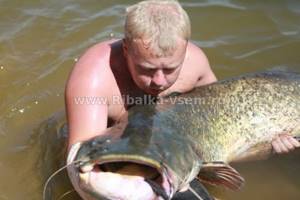
Mentions of the quok as a device for fishing were found in Greek opuses, in particular in the Iliad, as well as in historical studies of American authors who could not understand what the ox horn was used for during fishing. Meanwhile, according to L.P. Sabaneev, cow horns have long been used in Rus' for calling catfish as a sound bait, where a strong cord was inserted into the horn drilled at the sharp end, a weight and a large hook for bait were placed below. And this cow’s horn, splashing through the water and attracting curious catfish, was the prototype of the same quok that fishermen of the 21st century use.
Tackle for catching catfish
A fishing line 0.8 mm thick is wound onto the reel for about 50-60 meters. The sinker is used weighing from 150-300 grams. Hook number 30 is used.
We thread a stainless steel wire into the sinker and make ears at the ends. We tie the main fishing line into one eye, and a leash with a hook into the other. Make sure your hooks are always well sharpened.
Using a rod with a reel is possible, but such gear must be of very high quality, and such gear is very expensive.
Tackle for catfish from a boat
When going fishing, you need to take care of preparing all the necessary equipment in advance. For example, you can catch catfish from a boat:
- in a plumb line to a quok;
- for spinning;
- trolling with wobblers;
- for bottom tackle.

The most common is the first method. It involves using a special kwok device that makes a sound that attracts catfish to the boat. An appetizing bait awaits the fish that swims up here, which is immediately swallowed and the catfish ends up on your hook.
When fishing with a spinning rod from a boat, two methods are used:
- trolling;
- tossed
In this case, fishing takes on a completely different vision, but this does not make it more exciting and interesting. Fishing rods for catfish most often use plug rods, which are additionally reinforced with rings. Their length should be no more than 3 meters, otherwise maneuverability during fishing is lost. The reel chosen is inertia-free with a friction brake.
Experienced fishermen most often catch catfish the “old-fashioned way” using bottom gear, claiming that it is the most successful. This equipment consists of a durable nylon cord wound on a reel, a weight and hooks. It is not difficult to make, and, in addition, it is excellent for fishing both from a boat and from the shore.
But no matter what gear is chosen, we must not forget that catfish fishing is characterized by an active nature. The angler will have to row a lot and fight on the water with a strong and dexterous opponent. In some ways, this process is similar to hunting a large animal. He is just as passionate and exciting.
Fishing technique
It’s worth going together to catch catfish using kwok. If a large catfish bites, it is almost impossible to pull it out alone, so we bait the tackle and lower it to a depth of 5-7 meters. Under no circumstances should we wrap fishing line around our hand. If a large catfish bites, it can drag you away. Next, we begin to squawk, make three sharp blows and pause for 20 seconds. We immerse the quok no more than 10 cm in water. If there is no bite at a promising place, be sure to return to this place a little later and try again.
As soon as the catfish hears the sound of a quok, it rises up and meets the bait on its way. He grabs it and goes into the depths, this is a bite. More precisely, it just pulls down and that’s it. Next, we take a short pause, allowing him to swallow the bait more forcefully, and sharply hook him. We make a sharp but short hook.
A large catfish can bite with a very strong jerk, you need to be prepared for this so as not to pull the tackle.
After hooking, we release the catfish, and then begin to fish it out. It all depends on the size of the fish caught. If it’s 10-15 kg, then feel free to pull it out, if it’s larger, then let it get tired and only then pull it out.
Fishing
As mentioned above, do not rush into hooking. The predator must take the bait well; to do this, drop several meters of fishing line. The fish is very strong, and therefore the process of fishing will be quite long and labor-intensive.
You should not fight fish at close range, as you will get tired faster. Lower the line as needed and let the catfish roam around so that it doesn’t break the line. Just don’t let it lie on the bottom, otherwise it will be quite difficult to lift it from there.
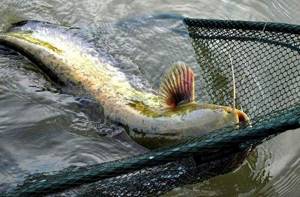
It is important not to forget that catching large catfish with a kwok requires the fisherman to be in good physical condition and possess certain skills. Therefore, try not to force this process, but first kill the fish, then bring it to the boat.
Fishing on the Tsimlyansk Reservoir video
Video application “Cool place” video
Tsimlyanskoye Reservoir, Rostov Region. Fish: Taran. Time: End of January.
Catching rams on the Tsimlyansk Reservoir video.
We found ourselves in the middle of a crucian distribution, and the fishing line is already cracking!\ Fishing with an overnight stay
Fishing from the shore to the feeder. Tsimlyansk Reservoir. The riverbed of the Don.
Catching catfish on Tsimla video
Catfish quoting at the Tsimlyansk Reservoir. Yuri Philosopher.
Catching catfish in the Lower Volga
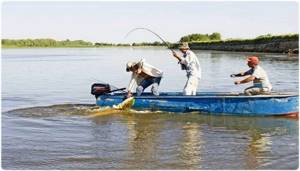
The catfish fishing season in the Lower Volga begins in May. At this time, the predator stays in holes and, as the water warms, goes out hunting more and more often. They catch it with a donka, vertical lure and jig. At the end of the flood, in mid-June, when the water rolls off the floodplains and flood lakes, catfish in whole flocks guard their prey near the streams - “outflows”. Having thrown a live bait or a frog into the depths of the creek itself, you won’t have to wait long for a bite.
In July-August, in the heat of the day and in the evening on calm, quiet water, the best time for fishing is with a quok over the pits. Catching catfish by trolling in low water, in mid-summer and closer to autumn, is especially exciting. They catch catfish by trolling on the rifts, at the exits of the pits, sending the boat at a slow speed against the current. By combing the edges of the duct with bait, sometimes you even manage to see the very exit to attack by a seasoned predator. Suddenly, from the side of the line of movement of the bait, whiskers diverge through the water, as if a submarine is going across the wobbler. The squeal of the coil is there!

An exciting fight with the mighty fish begins. Even with powerful, time-tested gear, it is not always possible for an angler to emerge victorious in a fight with catfish. The “mustachioed” one is helped by snags, heroic strength, and the slightest mistakes of the fisherman. This unpredictability is the beauty of catfish fishing. Gambling fishing by all means continues until late autumn. In October, as the water gets colder, the catfish rolls into holes and stops being caught.
There are no trifles in catching catfish; in addition to good-quality tackle and a reliable boat, you will need knowledge of catfish places and habits. The help of local fishermen or a huntsman guide is invaluable. And when fishing with a quack, the result primarily depends on the talent of the quack fisherman.
It is unlikely that you will be able to study the river on your own in a few days of fishing, and despite the fact that catfish grounds are located throughout the Volga and its channels, without knowing exactly where, when and what to catch catfish with, fishing can be turned into a lottery. Catching trophy fish can only happen by accident.
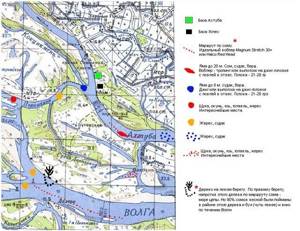
There are good catfish pits both in the Parashkina channel and on Akhtuba. The best places for trolling are on the riffles of the Parashkina channel, in the very place where it turns almost at a right angle, as well as at the confluence of the Poldanilovka channel into the Volga. Here, between the islands, the current splits into two streams, holes and deep channels alternate with shallows and banks on which sabrefish and other “white fish” spin—a better pasture for predators cannot be found. The variety and number of catfish sites on the Volga and its channels defy description.

And if you haven’t yet experienced the exciting passion of fighting with big fish, don’t hesitate, come and win!
